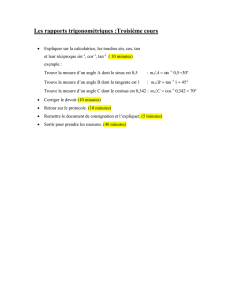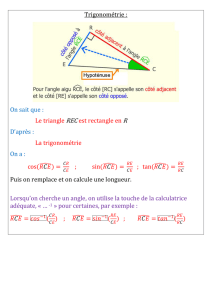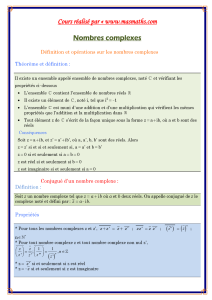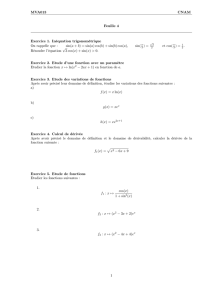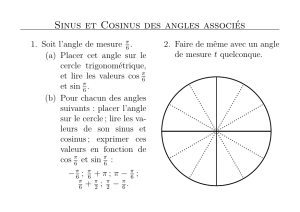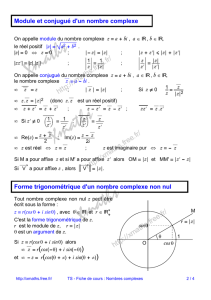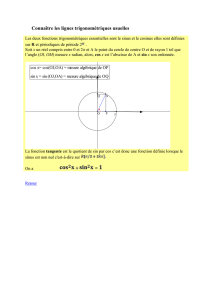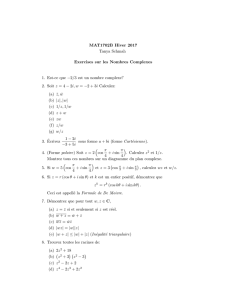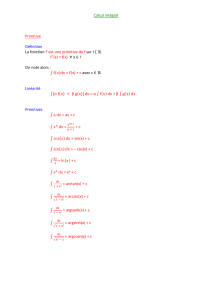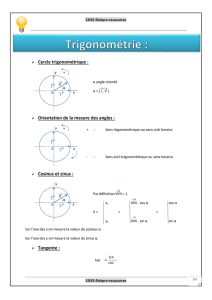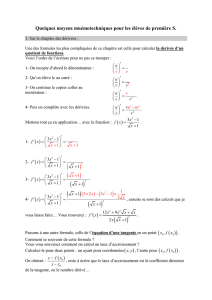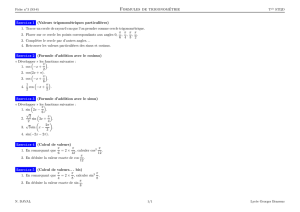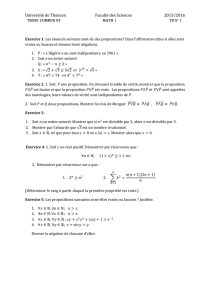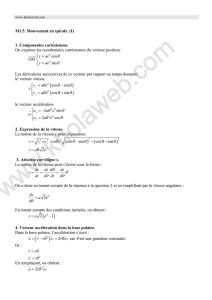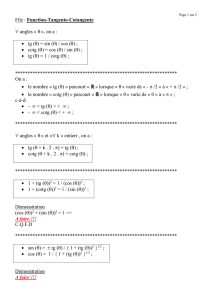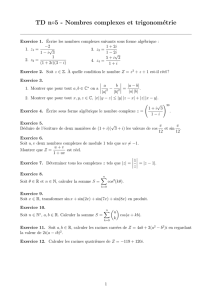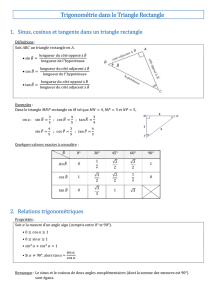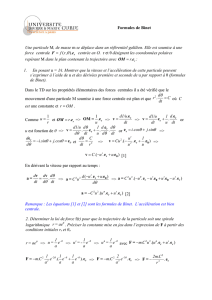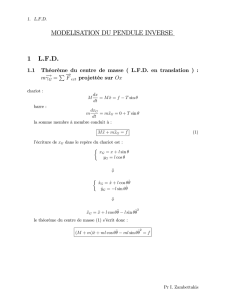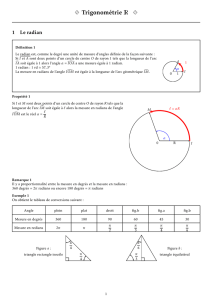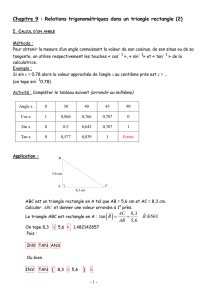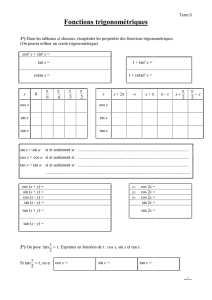Document PDF
publicité
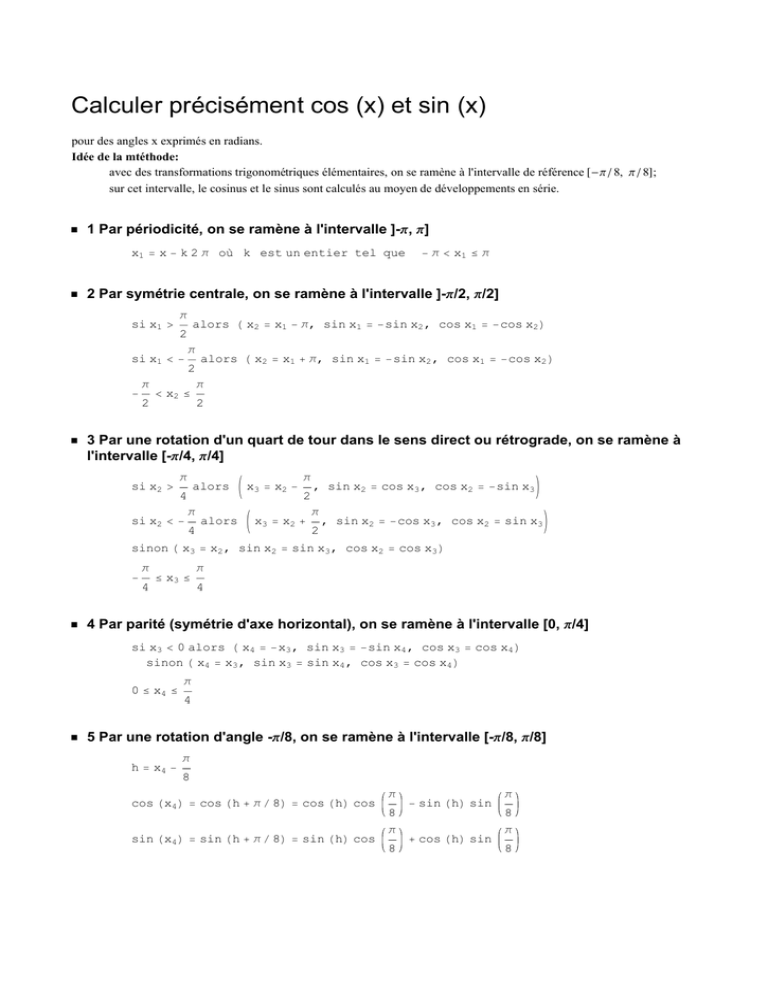
Calculer précisément cos (x) et sin (x) pour des angles x exprimés en radians. Idée de la mtéthode: avec des transformations trigonométriques élémentaires, on se ramène à l'intervalle de référence @-Π 8, Π 8D; sur cet intervalle, le cosinus et le sinus sont calculés au moyen de développements en série. 1 Par périodicité, on se ramène à l'intervalle ]-Π, Π] x1 = x - k 2 Π où k est un entier tel que - Π < x1 £ Π 2 Par symétrie centrale, on se ramène à l'intervalle ]-Π/2, Π/2] si x1 > 2 si x1 < - Π 2 alors H x2 = x1 - Π, sin x1 = -sin x2 , cos x1 = -cos x2 L Π Π 2 alors H x2 = x1 + Π, sin x1 = -sin x2 , cos x1 = -cos x2 L Π < x2 £ 2 3 Par une rotation d'un quart de tour dans le sens direct ou rétrograde, on se ramène à l'intervalle [-Π/4, Π/4] si x2 > alors K x3 = x2 - Π 4 si x2 < - Π 4 Π 2 alors K x3 = x2 + , sin x2 = cos x3 , cos x2 = -sin x3 O Π 2 , sin x2 = -cos x3 , cos x2 = sin x3 O sinon H x3 = x2 , sin x2 = sin x3 , cos x2 = cos x3 L - Π 4 £ x3 £ Π 4 4 Par parité (symétrie d'axe horizontal), on se ramène à l'intervalle [0, Π/4] si x3 < 0 alors H x4 = -x3 , sin x3 = -sin x4 , cos x3 = cos x4 L sinon H x4 = x3 , sin x3 = sin x4 , cos x3 = cos x4 L 0 £ x4 £ Π 4 5 Par une rotation d'angle -Π/8, on se ramène à l'intervalle [-Π/8, Π/8] h = x4 - Π 8 cos Hx4 L = cos Hh + Π 8L = cos HhL cos Π sin Hx4 L = sin Hh + Π 8L = sin HhL cos Π 8 8 - sin HhL sin Π + cos HhL sin Π 8 8 2 cossin.nb 4 Développements en série On utilise maintenant les développements en série bien connus cos HhL = 1 sin HhL = h - h2 + 2! h3 3! h4 - 4! + h5 5! h6 + 6! - h7 7! h8 - 8! + h9 9! h10 10 ! - h11 + h12 - ... 12 ! + ... 11 ! 5 Algorithme Représentation interne: (Α désigne la valeur courante de l'angle x après les transformations trigonométriques): x = angle en radians; ndecim = nombre de décimales (précision du calcul); (cc, cs) coefficients de la représentation cos x = cc*cos(Α) + cs*sin(Α) (sc, ss) coefficients de la représentation sin x = sc*cos(Α) + ss*sin(Α) ch, sh désignent les développements en série de cos(h), sin(h) c8 = cos(Π/8); s8 = sin(Π/8); input (x, ndecim) pix2=6.2831853071795864769252867665590058; pi=3.1415926535897932384626433832795029; pid2=1.5707963267948966192313216916397514; pid4=0.78539816339744830961566084581987572; pid8=0.39269908169872415480783042290993786; c8=0.92387953251128675612818318939678829; s8=0.38268343236508977172845998403039887; eps = 1.E-ndecim; cc=1; cs=0; sc=0; ss=1; Tant que x > pi x = x - pix2; Tant que x <= -pi x = x + pix2; Si x > pid2 x=x-pi; cc=-cc; ss=-ss; sinon si x < -pid2 x=x+pi; cc=-cc; ss=-ss; Si x > pid4 x= x-pid2; cs=-cc; cc=0; sc=ss; ss=0; sinon si x < -pid4 x= x+pid2; cs=cc; cc=0; sc=-ss; ss=0; h=x-pid8; ch=1; d=1; n=0; h2=h*h; hn=1; répète n=n+2; hn=hn*h2; d=d*(n-1)*n; ch=ch - hn/d; n=n+2; hn=hn*h2; d=d*(n-1)*n; t = hn/d; ch=ch + t; jusqu'à ce que abs(t) < eps; sh=h; d=1; n=1; hn=h; répète n=n+2; hn=hn*h2; d=d(n-1)*n; sh=sh - hn/d; n=n+2; hn=hn*h2; d=d(n-1)*n; t=hn/d; sh=sh + t; jusqu'à ce que abs(t) < eps; cosx= Hcc * ch + cs * shL * c8 - Hsc * ch + ss * shL * s8; sinx= Hsc * ch + ss * shL * c8 + Hcc * ch + cs * shL * s8; répète n=n+2; hn=hn*h2; d=d*(n-1)*n; ch=ch - hn/d; n=n+2; hn=hn*h2; d=d*(n-1)*n; t = hn/d; ch=ch + t; jusqu'à ce que abs(t) < eps; sh=h; d=1; n=1; hn=h; répète n=n+2; hn=hn*h2; d=d(n-1)*n; sh=sh - hn/d; n=n+2; hn=hn*h2; d=d(n-1)*n; t=hn/d; sh=sh + t; jusqu'à ce que abs(t) < eps; cosx= Hcc * ch + cs * shL * c8 - Hsc * ch + ss * shL * s8; sinx= Hsc * ch + ss * shL * c8 + Hcc * ch + cs * shL * s8; Lien hypertexte vers la page mère http://www.deleze.name/marcel/sec2/cossin/index.html cossin.nb 3
